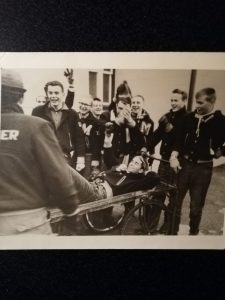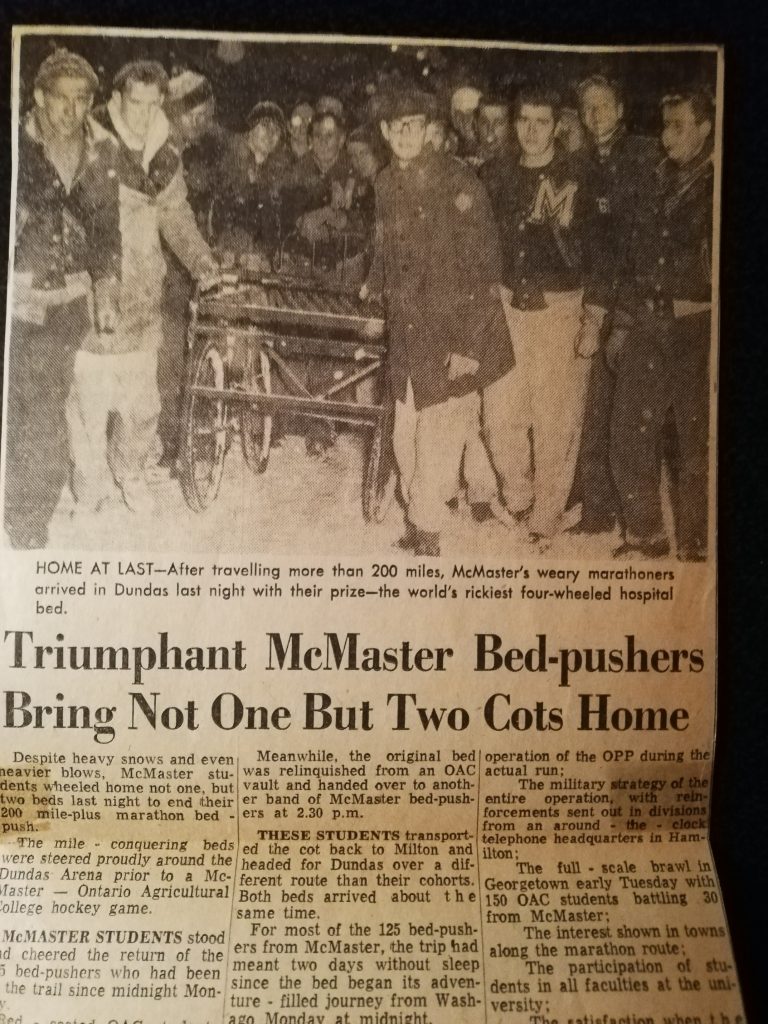317 miles, four wheels and two world records: 60 years since the greatest bed-pushing story ever told

It's been 60 years since an elaborate plan involving near-military precision, support vehicles, a custom-made bed and a relay of 100 to 125 maroon-and-grey pushers beat the odds — and the Aggies from Guelph.
On Feb. 17, 1961, the front-page headline in The Silhouette trumpeted that McMaster had just claimed world records for both speed and distance in the most glorious of human endeavours, bed pushing.
Les Prince, then the coach of McMaster’s varsity hockey team, the Marlins, had imagined a publicity stunt to raise the profile of an upcoming game at Dundas Arena against Ontario Agricultural College (now known as the University of Guelph).
Mac students Jim McPherson, Levio “Red” Ferracuti, Jim Zeigler and a band of co-conspirators rose to Prince’s challenge by planning an epic two-day bed-pushing effort that would end at the arena in time for the drop of the puck.
With bed pushing explicitly banned from provincial highways (safety first!), the journey was to begin in Washago, Ont., just north of Orillia, about two hours from McMaster by car. Then about 41 hours by foot – taking advantage of the frozen Lake Couchiching and Lake Simcoe to make tracks without running afoul of the OPP.
 The elaborate plan involved near-military precision, support vehicles, a custom-made bed and somewhere between 100 and 125 maroon-and-grey pushers working as a relay team.
The elaborate plan involved near-military precision, support vehicles, a custom-made bed and somewhere between 100 and 125 maroon-and-grey pushers working as a relay team.
One of the pushers, Earl Cochrane, former president of the McMaster Alumni Association, remembers the long winter journey well.
“Great fun,” he said. “Well organized. We did a lot of pushing across farmers’ fields and kept adjusting the route to avoid the OPP. One of the pushers was injured lifting the bed over a fence, but we had a pub lunch along the way, cold beer and sunny days even though we did push through the nights.”
The most daunting obstacle to glory, however, was not weather, darkness, injury, or the local constabulary. It was meddling from OAC, the Aggies, who marshalled twice to hijack Mac’s rolling assault on the record books.

“The hijacking attempts happened around Georgetown,” recalled Jim McPherson.
“Now I think there’s some disagreement in the official record about what actually happened: The Sil reported that the bed was damaged but never captured. Lots of people talk about losing the bed, though, and having to negotiate an exchange with OAC.
“See, earlier we had accidentally acquired some sort of trophy that the Aggies thought was important. Or maybe it was a fire truck they used in parades. At least that’s the story. Then we may, or may not, have traded something of theirs for our bed. It’s hard to say. It was a long time ago.”
The journey concluded in a double triumph as the bed and its pushers arrived at Dundas Arena to cheers reported as “thunderous” and the Marlins, no doubt inspired to greatness by the rolling record breaking, thrashed the visiting Aggies on the ice.
The story caught the attention of Life magazine, which ran photographic evidence alongside a brief description of the McMaster-based exploits in their Feb. 24 issue:
It was the middle of winter, but north of the border the sap had already begun to run. With telephone booth packing taking old-hat, Canadian boys have taken to pushing beds around. It is a simple pastime. A group of students get a bed and push from one place to another. But rugged college students have turned it into a competitive sport which combines feats of logistics and endurance. One after another, competing schools claimed new world records – pushing a bed 70 miles in 8 1/2 hours, then 105 miles in less than 12 hours.
The well drilled team of nearly 100 students from Hamilton Ontario’s McMaster University shown here with a donated bed with bicycle wheels set a record in endurance and perseverance by completing 317 miles in 43 hours, in spite of being ruled off the highways by police, losing their way for six hours on a frozen lake, and having their bed hijacked by a rival group.
Six decades after the rolling, wintry events of February 1961, the memories are perhaps unreliable due to the passage of time and a long-lasting aversion to self-incrimination.
The press clippings may be brittle and yellowed.
The first-day Marlin pushers, Ron “Carp” Watson, Jim McLellan, Robert Brown, Bob Norman and other teammates hope to gather to reminisce about the adventure when public health and travel guidelines allow gatherings.
Until then, the legend of Mac’s bed-pushing heroes, however, remains strong and an enduring part of the lore of student life at McMaster.


